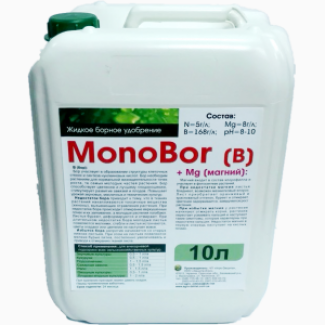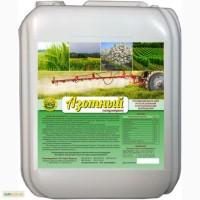/ Fertilizers and plant protection products / Organic fertilizers / Boron-magnesium liquid fertilizer BORON + MAGNESIUM "...
For sale / buy
Борно-магнивое жидкое удобрение БОР + МАГНИЙ «ДОБРЫЙ ХОЗЯИН», Черкасская обл.
Price360 UAH.
Region :all of Ukraine,
Cherkasskaya oblast.
(Bul. Shevchenko 266/1)
Updated:
BOR + MAGNY "GOOD MASTER"®
Liquid boron fertilizer with a high concentration of boron and magnesium enrichment, for foliar fertilization
Composition: Boron (B)=168g/l; Magnesium (Mg)=8 g/l; Nitrogen (N-NH2)=5g/l; pH≤8
Boron is the most important element of plant nutrition and a source of increasing the profitability of crop production.
Boron+magnesium "Good Host" provides: regular supply of boron in critical phases of plant development, stress resistance and resistance to low temperatures, and in combination with magnesium increases yield and improves flowering. Boron is contained in the highest possible concentration and in an easily digestible form for plants.
The following crops are most sensitive to boron deficiency: beets (sugar, table, fodder), rapeseed (winter and spring), soybeans, peas, beans, chickpeas, alfalfa, clover, leguminous seed crops, potatoes, tomatoes, carrots, cabbage, cauliflower cabbage, celery, broccoli, Brussels sprouts, corn,sunflower, flax, cotton, buckwheat, apple tree, pear, grapes, plum, citrus, berry crops.
Boron is involved in the formation of the structure of cell walls and the synthesis of nucleic acids. Sufficient supply of plants with boron increases the intensity of photosynthesis, improves carbohydrate and protein metabolism, activates the activity of enzymes, and has a positive effect on the processes of cell division.
In addition, the product is enriched with sugar, starch, vitamins, plant diseases are reduced. On soils poor in boron content, the application of boron fertilizers increases the yield of agricultural crops by 10-20%.
The presence of the necessary amount of boron is always important for the actively growing parts of the plant - new leaves, root tips, as well as for the development of buds. That is, boron helps cells multiply quickly, therefore, promotes active plant growth.
Boron has a positive effect on the accumulation of sugar in sugar beets, starch in potatoes, promotes the processes of flowering and fertilization, increases the yield and quality of seeds.
With boron deficiency in plants, the following signs appear:
• stoppage of root and stem growth;
• chlorosis of the apical growth point, and later, with severe boron starvation, its complete death;
• small amount of flowers and infertility;
• ugly shape of the fruits with the formation of inside the tissue, etc.(//tractor-service.com)
Boron deficiency leads to the accumulation of toxic substances (quinones) in plant tissues, which cause plant poisoning. With a lack of boron, the apical buds die off and rot, and young plants die. The leaves turn brown, deform and die. With a prolonged lack of boron, young leaves appear small, stems and leaves thin out, flowers fall or flowers do not appear at all.
Boron deficiency causes deep disturbances in carbohydrate metabolism in the plant: death of the growth point is observed, conduction system is disturbed, root supply of carbohydrates decreases.
This leads to weak development of the root system and is the main cause of plant disease (in rapeseed, cracking of the stem at the root neck is noted, the root system is deformed, overwintering worsens, flowering is delayed, becomes uneven, core rot or hollowness appears in beets, vascular necrosis in grapes, yellowing tops in alfalfa, browning of cauliflower, bacteriosis of flax, spread of scab in potatoes, etc.). Due to the disorder of the conduction system, carbohydrates accumulate in the leaves without reaching other parts of the plant, and the process of photosynthesis slows down.
After nitrogen, phosphorus and potassium, magnesium is the most important nutrient for plants. At the same time, magnesium plays a literally central role because it is part of chlorophyll and participates in the photosynthesis of plants. Without magnesium, the plant could not carry out photosynthesis.
With a lack of magnesium, the leaves turn pale, mesenteric chlorosis is possible. The leaf acquires an orange and reddish hue, turns brown and dies. Flowering is delayed, plant growth slows down.
When using liquid boronудобрения:
• Firstly, there is an opportunity to make a balanced solution, which, along with boron, will contain other microelements and agrochemicals necessary for this field and culture at the moment.
• Secondly, during the period of the maximum need for boron, growing plants cannot get this element in the required amount due to absorption only by the root system - the leaves are needed.
• Thirdly, the use of tank mixtures, which include boron as part of the fertilization program, allows farms to reduce costs for plant nutrition.
Method of application: for foliar fertilization of all agricultural crops:
Cereal crops (spring and winter): 0.5 - 1 l/ha
Corn: 0.5 - 1 l/ha
Sunflower: 1 - 1.5 l/ha
Beet (sugar, table and fodder): 0.5 - 1.5 l/ha
Soy andother legumes cultures: 1 - 1.5 l/ha
Rapeseed (spring and winter): 1 - 1.5 l/ha
Vegetable crops: 0.5 - 1 l/ha
Fruit and berry crops: 1 - 2 l/ha
Liquid boron fertilizer with a high concentration of boron and magnesium enrichment, for foliar fertilization
Composition: Boron (B)=168g/l; Magnesium (Mg)=8 g/l; Nitrogen (N-NH2)=5g/l; pH≤8
Boron is the most important element of plant nutrition and a source of increasing the profitability of crop production.
Boron+magnesium "Good Host" provides: regular supply of boron in critical phases of plant development, stress resistance and resistance to low temperatures, and in combination with magnesium increases yield and improves flowering. Boron is contained in the highest possible concentration and in an easily digestible form for plants.
The following crops are most sensitive to boron deficiency: beets (sugar, table, fodder), rapeseed (winter and spring), soybeans, peas, beans, chickpeas, alfalfa, clover, leguminous seed crops, potatoes, tomatoes, carrots, cabbage, cauliflower cabbage, celery, broccoli, Brussels sprouts, corn,sunflower, flax, cotton, buckwheat, apple tree, pear, grapes, plum, citrus, berry crops.
Boron is involved in the formation of the structure of cell walls and the synthesis of nucleic acids. Sufficient supply of plants with boron increases the intensity of photosynthesis, improves carbohydrate and protein metabolism, activates the activity of enzymes, and has a positive effect on the processes of cell division.
In addition, the product is enriched with sugar, starch, vitamins, plant diseases are reduced. On soils poor in boron content, the application of boron fertilizers increases the yield of agricultural crops by 10-20%.
The presence of the necessary amount of boron is always important for the actively growing parts of the plant - new leaves, root tips, as well as for the development of buds. That is, boron helps cells multiply quickly, therefore, promotes active plant growth.
Boron has a positive effect on the accumulation of sugar in sugar beets, starch in potatoes, promotes the processes of flowering and fertilization, increases the yield and quality of seeds.
With boron deficiency in plants, the following signs appear:
• stoppage of root and stem growth;
• chlorosis of the apical growth point, and later, with severe boron starvation, its complete death;
• small amount of flowers and infertility;
• ugly shape of the fruits with the formation of inside the tissue, etc.(//tractor-service.com)
Boron deficiency leads to the accumulation of toxic substances (quinones) in plant tissues, which cause plant poisoning. With a lack of boron, the apical buds die off and rot, and young plants die. The leaves turn brown, deform and die. With a prolonged lack of boron, young leaves appear small, stems and leaves thin out, flowers fall or flowers do not appear at all.
Boron deficiency causes deep disturbances in carbohydrate metabolism in the plant: death of the growth point is observed, conduction system is disturbed, root supply of carbohydrates decreases.
This leads to weak development of the root system and is the main cause of plant disease (in rapeseed, cracking of the stem at the root neck is noted, the root system is deformed, overwintering worsens, flowering is delayed, becomes uneven, core rot or hollowness appears in beets, vascular necrosis in grapes, yellowing tops in alfalfa, browning of cauliflower, bacteriosis of flax, spread of scab in potatoes, etc.). Due to the disorder of the conduction system, carbohydrates accumulate in the leaves without reaching other parts of the plant, and the process of photosynthesis slows down.
After nitrogen, phosphorus and potassium, magnesium is the most important nutrient for plants. At the same time, magnesium plays a literally central role because it is part of chlorophyll and participates in the photosynthesis of plants. Without magnesium, the plant could not carry out photosynthesis.
With a lack of magnesium, the leaves turn pale, mesenteric chlorosis is possible. The leaf acquires an orange and reddish hue, turns brown and dies. Flowering is delayed, plant growth slows down.
When using liquid boronудобрения:
• Firstly, there is an opportunity to make a balanced solution, which, along with boron, will contain other microelements and agrochemicals necessary for this field and culture at the moment.
• Secondly, during the period of the maximum need for boron, growing plants cannot get this element in the required amount due to absorption only by the root system - the leaves are needed.
• Thirdly, the use of tank mixtures, which include boron as part of the fertilization program, allows farms to reduce costs for plant nutrition.
Method of application: for foliar fertilization of all agricultural crops:
Cereal crops (spring and winter): 0.5 - 1 l/ha
Corn: 0.5 - 1 l/ha
Sunflower: 1 - 1.5 l/ha
Beet (sugar, table and fodder): 0.5 - 1.5 l/ha
Soy andother legumes cultures: 1 - 1.5 l/ha
Rapeseed (spring and winter): 1 - 1.5 l/ha
Vegetable crops: 0.5 - 1 l/ha
Fruit and berry crops: 1 - 2 l/ha
|
Shop, contacts | |
Grydnev K.K. / отзывы, инфо. / activity assessment | |
|
Phone:
( 067xxxxxx. Write a letter to the author of the ad
показать
| |
| http://www.planeta2012.com.ua/ | |
All user ads ~37 | |
Ad ID: #497736
(added by a registered user, registration date: 07-09-2012)
Added/Updated: 10-03-2024 13:31 (current, until: 03-10-2025)
Permanent ad address:
Showed / watched for today: ?, total: ?
Similar ads
Among them there are many interesting...








